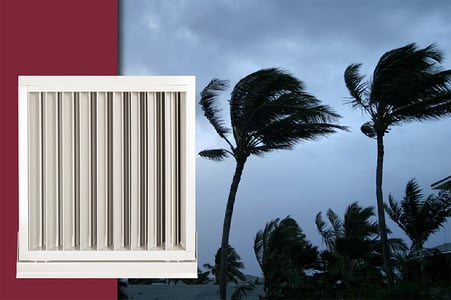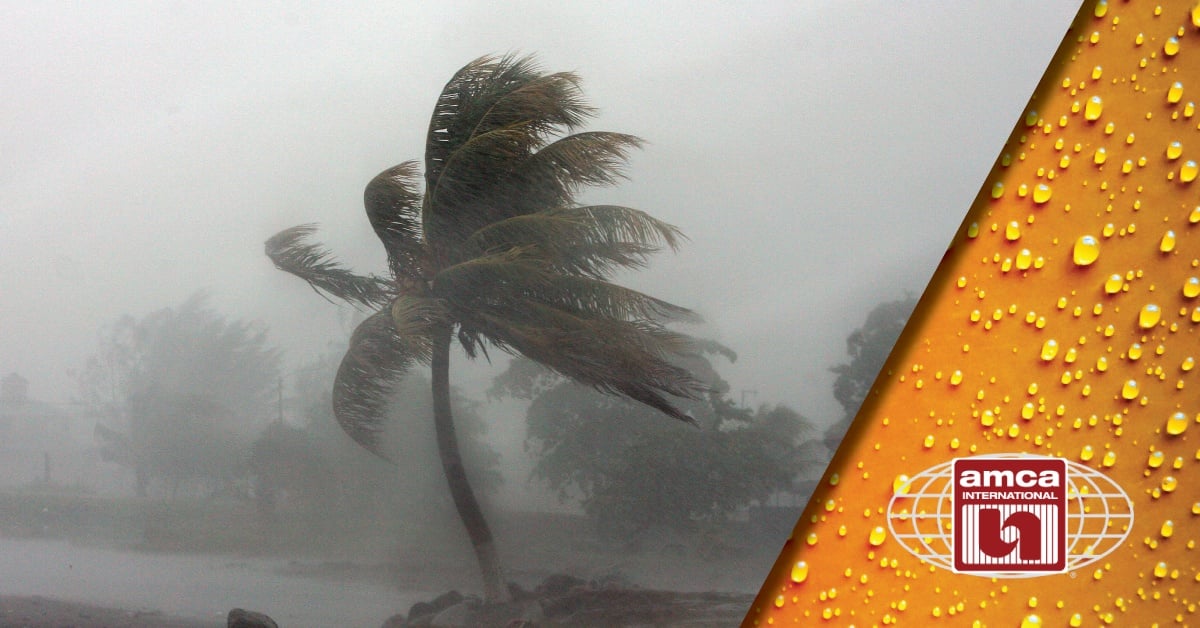The Air Movement and Control Association (AMCA) provides test standards for wind driven rain louvers. Learn about the test process and rating in this article.
Louvers let air in while keeping other things out, like rain or snow. When picking a louver, you need to know which of these two is more important. AMCA Ratings can help you determine which louvers are best for a task.
AMCA - A Quick Review
First, let's review. AMCA stands for the Air Movement and Control Association: an international, not-for-profit association of manufacturers who build air-system components, including fans, louvers, dampers, air-flow measurement devices, and other HVAC components.
AMCA establishes reliable standards and test protocols for HVAC equipment. After testing an air-flow product under these protocols, AMCA issues an AMCA Rating Seal. Industry professionals look for these seals when selecting air-control products.
Need severe weather louvers? Contact Arrow United Industries and let's get started!
The Test
Wind Driven Rain testing involves two assemblies: one that mimics an air intake duct and another that mimics rainfall in windy conditions.
For the first assembly, testers install a sample louver, measuring 1 meter wide by 1 meter high, in a simulated opening. The assembly connects to ductwork that leads to a fan, which will draw air through the louver and into the duct. This first assembly simulates an intake duct during standard operation, as it does in the Water Penetration test.

The second assembly comprises a fan connected through ductwork to a series of water sprinklers on the other end. These sprinklers will face the sample louver and spray water directly at the louver face, while the fan drives the water forward. This second assembly will simulate wind-driven rain.
For the Wind Driven Rain test, technicians test each louver at two simulated rainfall rates.
- Three inches of rainfall per hour, at a wind velocity of 29 MPH
- Eight inches of rainfall per hour, at a wind velocity of 50 MPH.
The goal of Wind Driven Rain testing is to ensure that the louver will block heavy rain fall while allowing air flow through the louver.
The Results
Testers collect data at several points in each test as the Core Ventilation rises. They record Free Area Ventilation (the amount of air coming in through the louver), Free Area Velocity (the speed of the air), and an Effectiveness Ratio.

The Effectiveness Ratio is the percentage of total rainwater blocked by the louver during the test, which corresponds to the Effectiveness Rating Class.
- Class A: 100 to 99% Effectiveness Rating
- Class B: 98.9% to 95% Effectiveness Rating
- Class C: 94.9% to 80% Effectiveness Rating
- Class D: 79.9% Effectiveness Rating or below
When both tests are complete, testers record the test data in a table for each test point, including the Effectiveness Rating Class. This table allows you to gauge the louver’s effectiveness through the course of both tests. This will give you an accurate understanding of its capabilities in real-world situations.
Meeting Requirements - Wind Driven Rain & Severe Weather
If you’re deciding on a wind driven rain louver, you have a requirement for how well the louver blocks heavy rainfall.
You may need to ventilate a room with electrical equipment, such as computers or generators. Or severe weather events may be common in your area.
In these instances, your goal should be to keep your interior spaces dry. A standard louver may provide some protection from rainwater, but they will fail at blocking serious weather. These AMCA tests rate wind-driven rain louvers for protection against severe weather. For severe weather requirements, always look for the wind driven rain seal.
One More Thing - Hurricanes!
Manufacturers test Wind Driven Rain louvers to reject heavy rainfall at high wind speeds, but sometimes you need more protection. What if you’re building in a High Velocity Hurricane Zone (HVHZ)?
In a Category 1 hurricane, wind speeds can be as low as 74 MPH or as high as 94 MPH. Those wind speeds are well above the maximum speed of the Wind Driven Rain test. And worse, that’s just the first category. In these cases, you would need a hurricane resistant louver.

A hurricane louver withstands hurricane-force wind, heavy rainfall, and impacts from windborne debris. Miami-Dade County and AMCA provide the test standards for these. Miami-Dade County must approve each louver for HVHZs.
AMCA rates hurricane louvers under AMCA Standard 540 for windborne debris impact resistance and AMCA Standard 550 for high-velocity wind-driven rain resistance. Read our article on AMCA Standards 540 & 550 for more information.
For more on louvers, read these Newsstand articles:
- AMCA Testing - AMCA Seals for Louvers
- The Condenser - Chevron Blades for Severe Weather
- Combination Stationary - Two-in-One Louver Solutions
Wind driven rain is an important requirement for severe weather preparedness. Have you installed or purchased wind driven rain louvers for a project? Are they common in your area? Share your thoughts in the Comments section. MCDLG wants to hear from you!
Do you have a question on something we haven't covered here? Or do you need help from industry experts? MCDLG can help. Contact us by clicking on the button below.
.webp?width=91&height=70&name=MCDLG%20Logo%20(Resize).webp)

.webp?width=300&height=200&name=Storm-pexels-photo-371838%20(Resize).webp)




